RSS and Forest Satyagraha: Role of Sangh swayamsevaks
28 Aug 2022 00:00:01
The Sangh maker Dr. Hedgewar was a lifelong champion of Complete Independence. To him, any agitation that furthered the cause of Complete Independence was worthy of active support. So it is not surprising that he participated in the Forest Satyagraha and courted imprisonment. However, a leader ought not to be judged solely on the basis of his individual exploits.
The hallmark of a true leader is his ability to inspire his followers to emulate him even in his absence. ‘Lead by example’, not ‘lead by directive’ was a peculiar trait of Hedgewar. In the absence of any directive from the leader, did the followers measure up to his leadership? In short, what were Hedgewar’s followers doing during the Forest Satyagraha while he was counting time in Jail?
Sangh office-bearers in the Forest Satyagraha
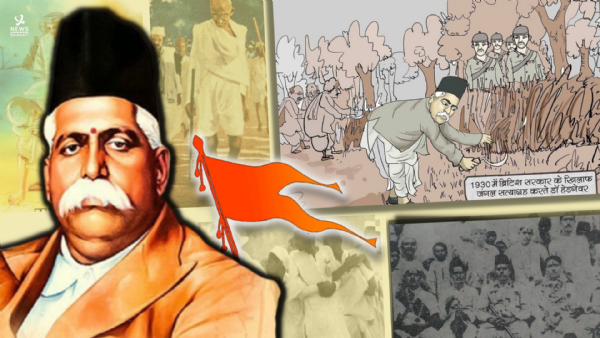
The core team of the Sangh at that time consisted of Sarsanghachalak Dr. Hedgewar, Sarsenapati Martandrao Jog, Sarkaryavah Balaji Huddar, Dr.L.V.Paranjpe, Anant Ganesh alias Anna Sohoni, Moreshwar Shridhar alias Abaji Hedgewar, Vishwanath Vinayak Kelkar and Appaji Joshi. It is significant that except for Paranjpe, Sohoni, Abaji and Kelkar, all others took part in the Forest Satyagraha. In all probability, the others stayed out by design to take care of the fledgling Sangh.
Ordinary Sangh swayamsevaks in the Forest Satyagraha
Though the Sangh was started in Nagpur in 1925, at most other places, it was barely a year or two old. In most places, Sangh work was irregular. In places where the total population was in a few thousands, the number of Sangh swayamsevaks did not touch hundred. What was the strength of the Sangh before the Forest Satyagraha? In his annual report to the Dusshera Utsav on 12 October 1929, Sarkaryavah Balaji Huddar remarked that the Sangh had a total of 40 shakhas in Central Provinces, Berar and a few other Provinces. Of these, at least 18 shakhas were in Nagpur and at least 12 were in Wardha district. The Sangh was largely limited to the Marathi-speaking districts of the Central Provinces viz. Nagpur, Wardha, Chanda and Bhandara. It was largely unknown in the Berar districts of Amravati, Buldhana, Akola and Yavatmal. That hundreds of swayamsevaks of an infant Sangh that was largely limited to two districts participated in the Forest Satyagraha is an achievement of no mean significance.
From available information in the Sangh archives (Sangh archives, Hedgewar papers, registers\Register 3 DSC_0048- DSC_0061), the tentative list of Sangh swayamsevaks who participated in the Forest Satyagraha (with their quantum of punishment if available in brackets) is as follows:
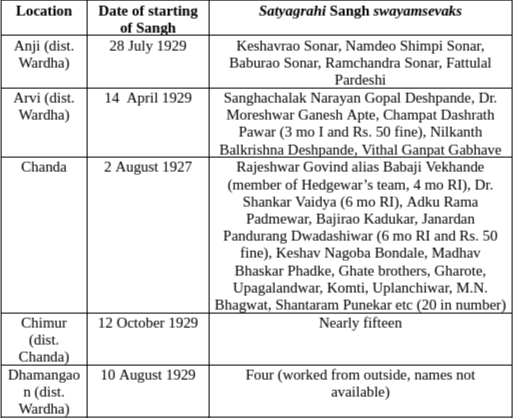
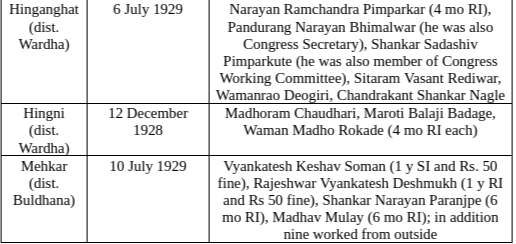
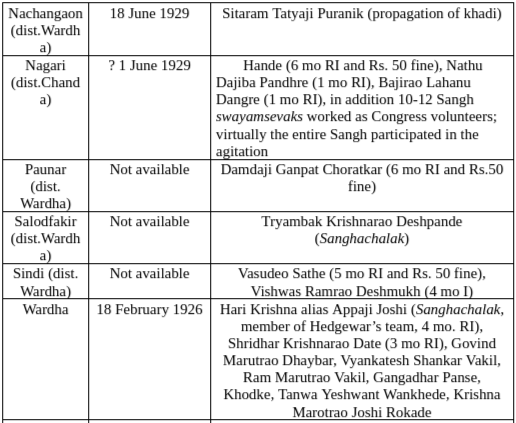
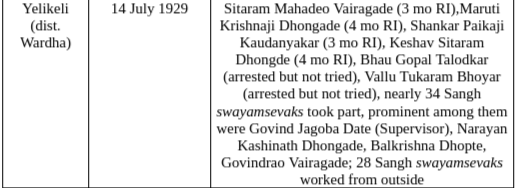 Anti-British activities during Forest Satyagraha
Anti-British activities during Forest Satyagraha
On the morning of 2 August 1930, the interim Congress President Vallabhbhai Patel, Pandit Madan Mohan Malaviya and seven other Congress leaders were arrested in Mumbai (Chaudhary, p.362). In protest, the C.P. War Council announced a Boycott Week from 3 August. Garhwal Day was observed on 8 August. As a precautionary measure, troops from Kamptee were marched through Nagpur in the morning to disperse the crowd of around 50,000 that had gathered in front of the Congress office. A prohibited procession that started at 2.30 pm was held up by the police till midnight when the order for Section 144 expired (Chaudhary, p.1015). Sixty uniformed swayamsevaks of the ambulance corps of the Sangh were continuously distributing water to the processionists from 1 pm to 1 am the next morning. This ambulance corps had been raised by Dr.Paranjpe on instructions from Hedgewar (Sangh archives, Hedgewar papers, registers\register 7\DSC_0247).
On 9 September 1930, two youths from Ramtek received flogging punishment in Nagpur Jail for their involvement in the Forest Satyagraha. A protest meeting was held on that day and a hartal was announced for the next day. Batches of volunteers picketed the Law Courts, Secretariat and other Government offices. To clear the Law Compound of excited protestors, mounted police rushed in, severely injuring four people. The President of the C.P. War Council P.K. Salve and three others were arrested. At 4 p.m. a procession of about 20,000 persons including 1,000 women, escorted the two whipped satyagrahis through the city. The satyagrahis were carried on stretchers in motor-cars and behind them followed a large placard illustrating their punishment (Chaudhary, p. 1036). Thirty-two uniformed swayamsevaks of the ambulance corps participated in the procession. On 11 September, there was a meeting of about 3,500 persons to congratulate the volunteers arrested the previous day. Sarsanghachalak Dr. L. V. Paranjpe was among the speakers (Chaudhary, p. 1038).
To protest against the atrocities committed on jailed Congress leader Barrister M.V. Abhyankar, the C.P. War Council called for 24 October 1930 to be observed as ‘Abhyankar Day’. The Sangh was invited for this programme. Sangh swayamsevaks took part in the band in their personal capacity. The uniformed ambulance corps of the Sangh also participated (Sangh archives, Hedgewar papers, registers\register 7\DSC_0249, DSC_0250).
Impact of Forest Satyagraha on Sangh activities
Sangh activities continued at their usual pace even after Hedgewar’s arrest. In the month of July when Hedgewar was arrested, three meetings of the Karyakari Mandal (Working Committee) of the Sangh and one meeting of Sangh instructors took place. After the college vacations got over, the regular lathi (stick) classes of the Sangh resumed on a regular basis. A plan was chalked out to collect subscriptions for the Sangh. Military drills were now taken outside the Sanghasthan (lit. meeting place of the Sangh). The daily work of the Sangh in Nagpur was being looked after by Anna Sohoni, Senapati Yashwant Narayan alias Bapurao Ballal, Karyavah Krishna Nilkanth Moharir, Hedgewar’s uncle Abaji and others. Sarsanghachalak Dr. Paranjpe and Vishwanathrao Kelkar would oversee Sangh activities. Dr. Paranjpe would meet Hedgewar in jail on a regular basis. Sangh swayamsevaks would be informed about Hedgewar’s well-being at regular intervals (Sangh archives, Hedgewar papers, registers\register 7\DSC_0242, DSC_0244).
During the Dussehra marchpast of the Sangh held on 2 October 1930, Sangh swayamsevaks faced the Nagpur Jail where Sarsenapati Martandrao Jog was lodged and later faced the house of interred Congress leader M.V. Abhyankar and gave a military salute. During Hedgewar’s imprisonment, some anti-Sangh elements started creating trouble for the Sangh activities at the Mohite Sanghasthan which was the centre of Sangh activity. Due to the munificence of the Nagpur royalty, in particular Raje Laxmanrao Bhonsale, the Kendra Sanghasthan was shifted to the Bhonsale Hattikhana (lit. complex to house elephants) on 24 December 1930 (Sangh archives, Hedgewar papers, registers\register 7\DSC_0292).
In addition to Sangh work, Sangh swayamsevaks took part in other nationalist activities both at an individual and organizational level. The Rashtriya Utsav Mandal observed the death anniversary of Lokmanya Tilak at Sahastrachandi Mandir, Nagpur on 1 August 1930. The programme was held under the Presidentship of Maharashtra editor Gopal Anant Ogale and was prominently attended by Sarsanghachalak Dr. Paranjpe. The Sangh was in-charge of the arrangements (Sangh archives, Hedgewar papers, registers\register 7\DSC_0243).
Bhagat Singh, Sukhdeo and Rajguru were hanged on March 23, 1931. On 13 January 1931, four patriots were hanged in Solapur in connection with the killing of two policemen. On both the occasions, Sangh swayamsevaks gave a military salute in memory of the martyrs and Sangh work was suspended for the day. On 26 January 1931, routine Sangh classes were cancelled on the occasion of Independence Day and 55 Sangh swayamsevaks took part in the Congress procession in Nagpur. Pandit Motilal Nehru passed away on 6 February 1931. The Sangh was given a holiday in his memory on his next day.
Negative impact
The Forest Satyagraha had a negative impact on Sangh work at some places at least for some time. The Upasanghachalak (Deputy Sanghachalak) of Chimur (dist. Chanda) Madhav Narayan Bhope wrote to Hedgewar,
The report of the 1930 Dussehera Utsav of Allipur (dist.Wardha) has the following noting, “The entire Working Committee of last year is unchanged. Only Govindrao Chopde (Senapati and Treasurer) and Balaji Kothekar (Supervisor) have been relieved (of their posts) due to the ongoing agitation…Nowadays, 20-25 people are present in the Sangh…Most people do not attend due the ongoing agitation…all other instruction is at a standstill due to problems of space. Only prayer and exercises are held and there is no one to give instruction.” As per the 1921 Census, the population of Allipur was 4443 and by November 1929, there were 110 Sangh swayamsevaks (Sangh archives, Hedgewar papers, registers\Register 3 DSC_0062).
The following interesting noting is found in the report of the Dussehera Utsav held on 2 October 1930, “Due to the effect of the Congress on swayamsevaks, it is unlikely that the Utsav there (Brahmapuri, dist Chanda) too will be held with any enthusiasm and pomp…after arms-worship, worship of portraits of Sri Ramdas Swami, Sri Shivaji, Lokmanya, Gandhi and Vajradehi Hanuman was done” (Sangh archives, Hedgewar papers, registers\Register 3 DSC_0068).
Salutary impact
The Forest Satyagraha led to the expansion of the Sangh in Berar. It was expected that Hedgewar would offer satyagraha in Central Provinces as he belonged to that area. But he chose to offer it in Berar. At that time, the Sangh was largely unknown in Berar. Satyagrahis in Berar were kept in Akola Jail. From the Sangh point of view, it was fortuitous that Hedgewar was kept in Akola Jail. All the Congress workers who came in Hedgewar’s contact in Akola Jail became Sangh workers. After his release from Akola Jail, Hedgewar undertook a tour of Berar in August-September 1931 and started Sangh shakhas at various places in Berar. Several individuals who were active in the Civil Disobedience Movement came under Hedgewar’s influence and joined the Sangh.
Many of them were appointed as local Sanghachalaks by Hedgewar in September 1931 – Dr. Yadav Shrihari Aney (Wani, he was Hedgewar’s friend from his Calcutta days and was arrested on 1 August 1930), Dr. Prahlad Madhav Kale (Khamgaon), Dajisaheb Bedarkar (Akot), Shankar alias Annasaheb Dabir (Washim); for information of the participation of these individuals in the Forest Satyagraha, see Chaudhary pp. 888, 891, 897, 931, 942, 998, 1009, 1023. Bapusaheb Dau was appointed Sanghachalak of Darvha (dist. Yavatmal). The editor of ‘Uday’ paper Narayan Ramling Bamangaonkar was arrested in Amravati on 29 July 1930. He was appointed Sanghachalak of Amravati on 11 September 1933.
Chitale’s reminiscence
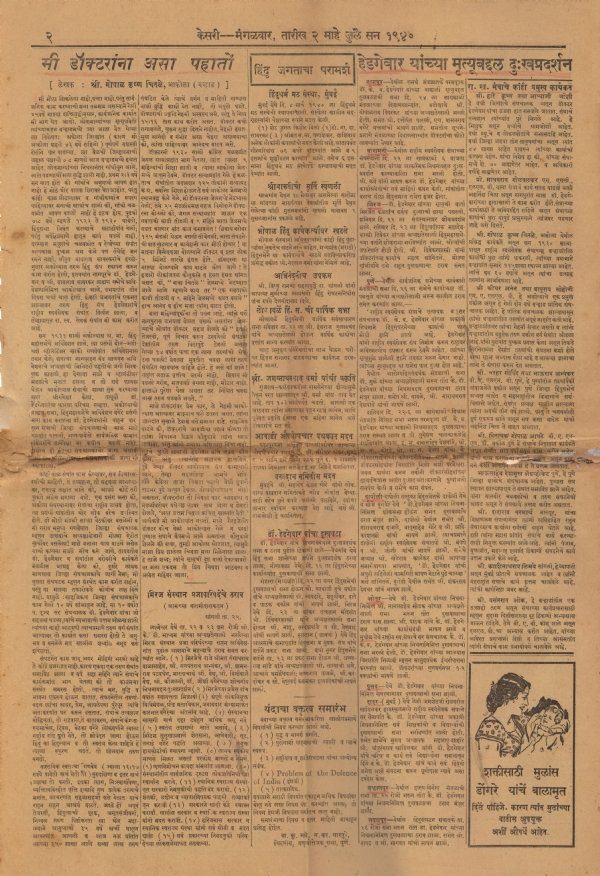
Hundreds of Sangh swayamsevaks participated shoulder to shoulder with Hedgewar in the Forest Satyagraha. The Sangh not only emerged unscathed from the involvement of Sangh swayamsevaks but in fact, it expanded in Berar. Sangh swayamsevaks displayed their nationalist spirit to their leader both within and outside the Sanghasthan in the absence of his formal directive. It all significantly shows that both the Sangh leaders and ordinary swayamsevaks actively participated in the freedom movement.
The hallmark of a true leader is his ability to inspire his followers to emulate him even in his absence. ‘Lead by example’, not ‘lead by directive’ was a peculiar trait of Hedgewar. In the absence of any directive from the leader, did the followers measure up to his leadership? In short, what were Hedgewar’s followers doing during the Forest Satyagraha while he was counting time in Jail?
Sangh office-bearers in the Forest Satyagraha
Besides Hedgewar, several office-bearers (or officers in Sangh parlance) took part in the Forest Satyagraha. At the first-ever meeting held in Nagpur on 1 May 1930 to observe the Salt Satyagaha, the first three satyagrahis to prepare contraband salt and read proscribed literature were Dr. B.S. Moonje, Dr. Moreshwar Ramchandra Cholkar and Gopal Mukund alias Balaji Huddar. Huddar was the Sarkaryavah (General Secretary) of the Sangh. In Hedgewar’s time, it was not the Sarkaryavah but the Sarsenapati (Chief Commander; this post is defunct in present-day Sangh) who was counted after the Sarsanghachalak. The first and only Sarsenapati of the Sangh Martand Parshuram Jog was appointed Assistant Commander in the Marathi C.P.War Council on 2 June 1930 (K.K.Chaudhary, ed. Source Material for a History of Freedom Movement, Civil Disobedience Movement, April-September 1930, Vol. XI, Gazetteers Department, Government of Maharashtra, Bombay, 1990, p. 947).

On 8 August 1930, Jog was appointed Captain of Volunteers in the Marathi C.P. War Council (Chaudhary, p. 1016). On 13 September 1930, Jog (and another Sangh swayamsevak named Bhaskar Badkas) was arrested for picketing at the Empress Mills and shifted first to Nagpur and then to Raipur Jail. He was released on 7 January 1931. The Secretary of Provincial Congress Committee and Wardha Sanghachalak Appaji Joshi, Salodfakir (dist. Wardha) Sanghachalak Tryambak Krishnarao Deshpande and Arvi (dist. Wardha) Sanghachalak Narayan Gopal Deshpande were in Hedgewar’s team of satyagrahis. They were awarded four months’ rigorous imprisonment. Dr. Moreshwar Ganesh Apte who succeeded Deshpande as Arvi Sanghachalak was also arrested (along with a Sangh swayamsevak named Bhaskar Hari Munje) on 27 August 1930. Nagpur District Sanghachalak Appaji Halde and Saoner Sanghachalak Narayan Ambokar also courted imprisonment during the Forest Satyagraha.
The core team of the Sangh at that time consisted of Sarsanghachalak Dr. Hedgewar, Sarsenapati Martandrao Jog, Sarkaryavah Balaji Huddar, Dr.L.V.Paranjpe, Anant Ganesh alias Anna Sohoni, Moreshwar Shridhar alias Abaji Hedgewar, Vishwanath Vinayak Kelkar and Appaji Joshi. It is significant that except for Paranjpe, Sohoni, Abaji and Kelkar, all others took part in the Forest Satyagraha. In all probability, the others stayed out by design to take care of the fledgling Sangh.
Ordinary Sangh swayamsevaks in the Forest Satyagraha
Though the Sangh was started in Nagpur in 1925, at most other places, it was barely a year or two old. In most places, Sangh work was irregular. In places where the total population was in a few thousands, the number of Sangh swayamsevaks did not touch hundred. What was the strength of the Sangh before the Forest Satyagraha? In his annual report to the Dusshera Utsav on 12 October 1929, Sarkaryavah Balaji Huddar remarked that the Sangh had a total of 40 shakhas in Central Provinces, Berar and a few other Provinces. Of these, at least 18 shakhas were in Nagpur and at least 12 were in Wardha district. The Sangh was largely limited to the Marathi-speaking districts of the Central Provinces viz. Nagpur, Wardha, Chanda and Bhandara. It was largely unknown in the Berar districts of Amravati, Buldhana, Akola and Yavatmal. That hundreds of swayamsevaks of an infant Sangh that was largely limited to two districts participated in the Forest Satyagraha is an achievement of no mean significance.
From available information in the Sangh archives (Sangh archives, Hedgewar papers, registers\Register 3 DSC_0048- DSC_0061), the tentative list of Sangh swayamsevaks who participated in the Forest Satyagraha (with their quantum of punishment if available in brackets) is as follows:




On the morning of 2 August 1930, the interim Congress President Vallabhbhai Patel, Pandit Madan Mohan Malaviya and seven other Congress leaders were arrested in Mumbai (Chaudhary, p.362). In protest, the C.P. War Council announced a Boycott Week from 3 August. Garhwal Day was observed on 8 August. As a precautionary measure, troops from Kamptee were marched through Nagpur in the morning to disperse the crowd of around 50,000 that had gathered in front of the Congress office. A prohibited procession that started at 2.30 pm was held up by the police till midnight when the order for Section 144 expired (Chaudhary, p.1015). Sixty uniformed swayamsevaks of the ambulance corps of the Sangh were continuously distributing water to the processionists from 1 pm to 1 am the next morning. This ambulance corps had been raised by Dr.Paranjpe on instructions from Hedgewar (Sangh archives, Hedgewar papers, registers\register 7\DSC_0247).
On 9 September 1930, two youths from Ramtek received flogging punishment in Nagpur Jail for their involvement in the Forest Satyagraha. A protest meeting was held on that day and a hartal was announced for the next day. Batches of volunteers picketed the Law Courts, Secretariat and other Government offices. To clear the Law Compound of excited protestors, mounted police rushed in, severely injuring four people. The President of the C.P. War Council P.K. Salve and three others were arrested. At 4 p.m. a procession of about 20,000 persons including 1,000 women, escorted the two whipped satyagrahis through the city. The satyagrahis were carried on stretchers in motor-cars and behind them followed a large placard illustrating their punishment (Chaudhary, p. 1036). Thirty-two uniformed swayamsevaks of the ambulance corps participated in the procession. On 11 September, there was a meeting of about 3,500 persons to congratulate the volunteers arrested the previous day. Sarsanghachalak Dr. L. V. Paranjpe was among the speakers (Chaudhary, p. 1038).
To protest against the atrocities committed on jailed Congress leader Barrister M.V. Abhyankar, the C.P. War Council called for 24 October 1930 to be observed as ‘Abhyankar Day’. The Sangh was invited for this programme. Sangh swayamsevaks took part in the band in their personal capacity. The uniformed ambulance corps of the Sangh also participated (Sangh archives, Hedgewar papers, registers\register 7\DSC_0249, DSC_0250).
Impact of Forest Satyagraha on Sangh activities
Sangh activities continued at their usual pace even after Hedgewar’s arrest. In the month of July when Hedgewar was arrested, three meetings of the Karyakari Mandal (Working Committee) of the Sangh and one meeting of Sangh instructors took place. After the college vacations got over, the regular lathi (stick) classes of the Sangh resumed on a regular basis. A plan was chalked out to collect subscriptions for the Sangh. Military drills were now taken outside the Sanghasthan (lit. meeting place of the Sangh). The daily work of the Sangh in Nagpur was being looked after by Anna Sohoni, Senapati Yashwant Narayan alias Bapurao Ballal, Karyavah Krishna Nilkanth Moharir, Hedgewar’s uncle Abaji and others. Sarsanghachalak Dr. Paranjpe and Vishwanathrao Kelkar would oversee Sangh activities. Dr. Paranjpe would meet Hedgewar in jail on a regular basis. Sangh swayamsevaks would be informed about Hedgewar’s well-being at regular intervals (Sangh archives, Hedgewar papers, registers\register 7\DSC_0242, DSC_0244).
During the Dussehra marchpast of the Sangh held on 2 October 1930, Sangh swayamsevaks faced the Nagpur Jail where Sarsenapati Martandrao Jog was lodged and later faced the house of interred Congress leader M.V. Abhyankar and gave a military salute. During Hedgewar’s imprisonment, some anti-Sangh elements started creating trouble for the Sangh activities at the Mohite Sanghasthan which was the centre of Sangh activity. Due to the munificence of the Nagpur royalty, in particular Raje Laxmanrao Bhonsale, the Kendra Sanghasthan was shifted to the Bhonsale Hattikhana (lit. complex to house elephants) on 24 December 1930 (Sangh archives, Hedgewar papers, registers\register 7\DSC_0292).
In addition to Sangh work, Sangh swayamsevaks took part in other nationalist activities both at an individual and organizational level. The Rashtriya Utsav Mandal observed the death anniversary of Lokmanya Tilak at Sahastrachandi Mandir, Nagpur on 1 August 1930. The programme was held under the Presidentship of Maharashtra editor Gopal Anant Ogale and was prominently attended by Sarsanghachalak Dr. Paranjpe. The Sangh was in-charge of the arrangements (Sangh archives, Hedgewar papers, registers\register 7\DSC_0243).
Bhagat Singh, Sukhdeo and Rajguru were hanged on March 23, 1931. On 13 January 1931, four patriots were hanged in Solapur in connection with the killing of two policemen. On both the occasions, Sangh swayamsevaks gave a military salute in memory of the martyrs and Sangh work was suspended for the day. On 26 January 1931, routine Sangh classes were cancelled on the occasion of Independence Day and 55 Sangh swayamsevaks took part in the Congress procession in Nagpur. Pandit Motilal Nehru passed away on 6 February 1931. The Sangh was given a holiday in his memory on his next day.
Negative impact
The Forest Satyagraha had a negative impact on Sangh work at some places at least for some time. The Upasanghachalak (Deputy Sanghachalak) of Chimur (dist. Chanda) Madhav Narayan Bhope wrote to Hedgewar,
“The collective Forest Satyagraha took place in Chimur on 24/8/30. There was a crowd of around 1500-1600 people. Their arrest started on 16/9/30 and by 22/9/30, fifteen persons were detained. As most of them are Sangh men, the attention of all other swayamsevaks was diverted. As a result, it may not be out of place to say that Sangh instruction has come to a standstill (for the past two months). Congress propagandists came to Chimur and started their lectures. Due to this, Sangh swayamsevaks and other villagers totaling 200 became Congress volunteers and took upon the work of Congress propaganda (Sangh archives, Hedgewar papers, registers\Register 3 DSC_0061). As per the 1921 Census, the population of Chimur was 5500 and by November 1929, there were 69 Sangh swayamsevaks in Chimur.”
The report of the 1930 Dussehera Utsav of Allipur (dist.Wardha) has the following noting, “The entire Working Committee of last year is unchanged. Only Govindrao Chopde (Senapati and Treasurer) and Balaji Kothekar (Supervisor) have been relieved (of their posts) due to the ongoing agitation…Nowadays, 20-25 people are present in the Sangh…Most people do not attend due the ongoing agitation…all other instruction is at a standstill due to problems of space. Only prayer and exercises are held and there is no one to give instruction.” As per the 1921 Census, the population of Allipur was 4443 and by November 1929, there were 110 Sangh swayamsevaks (Sangh archives, Hedgewar papers, registers\Register 3 DSC_0062).
The following interesting noting is found in the report of the Dussehera Utsav held on 2 October 1930, “Due to the effect of the Congress on swayamsevaks, it is unlikely that the Utsav there (Brahmapuri, dist Chanda) too will be held with any enthusiasm and pomp…after arms-worship, worship of portraits of Sri Ramdas Swami, Sri Shivaji, Lokmanya, Gandhi and Vajradehi Hanuman was done” (Sangh archives, Hedgewar papers, registers\Register 3 DSC_0068).
Salutary impact
The Forest Satyagraha led to the expansion of the Sangh in Berar. It was expected that Hedgewar would offer satyagraha in Central Provinces as he belonged to that area. But he chose to offer it in Berar. At that time, the Sangh was largely unknown in Berar. Satyagrahis in Berar were kept in Akola Jail. From the Sangh point of view, it was fortuitous that Hedgewar was kept in Akola Jail. All the Congress workers who came in Hedgewar’s contact in Akola Jail became Sangh workers. After his release from Akola Jail, Hedgewar undertook a tour of Berar in August-September 1931 and started Sangh shakhas at various places in Berar. Several individuals who were active in the Civil Disobedience Movement came under Hedgewar’s influence and joined the Sangh.
Many of them were appointed as local Sanghachalaks by Hedgewar in September 1931 – Dr. Yadav Shrihari Aney (Wani, he was Hedgewar’s friend from his Calcutta days and was arrested on 1 August 1930), Dr. Prahlad Madhav Kale (Khamgaon), Dajisaheb Bedarkar (Akot), Shankar alias Annasaheb Dabir (Washim); for information of the participation of these individuals in the Forest Satyagraha, see Chaudhary pp. 888, 891, 897, 931, 942, 998, 1009, 1023. Bapusaheb Dau was appointed Sanghachalak of Darvha (dist. Yavatmal). The editor of ‘Uday’ paper Narayan Ramling Bamangaonkar was arrested in Amravati on 29 July 1930. He was appointed Sanghachalak of Amravati on 11 September 1933.
Chitale’s reminiscence
Akola Sanghachalak Gopal Krishna alias Babasaheb Chitale was senior to Hedgewar in age and had boundless affection for him. The following reminiscence written by Chitale is significant, “On learning that Doctor has gone for satyagraha, 125 responsible Sangh individuals offered satyagraha. All were awarded punishment and interred in Akola Jail” (Kesari, 2 July, 1940).

Hundreds of Sangh swayamsevaks participated shoulder to shoulder with Hedgewar in the Forest Satyagraha. The Sangh not only emerged unscathed from the involvement of Sangh swayamsevaks but in fact, it expanded in Berar. Sangh swayamsevaks displayed their nationalist spirit to their leader both within and outside the Sanghasthan in the absence of his formal directive. It all significantly shows that both the Sangh leaders and ordinary swayamsevaks actively participated in the freedom movement.
